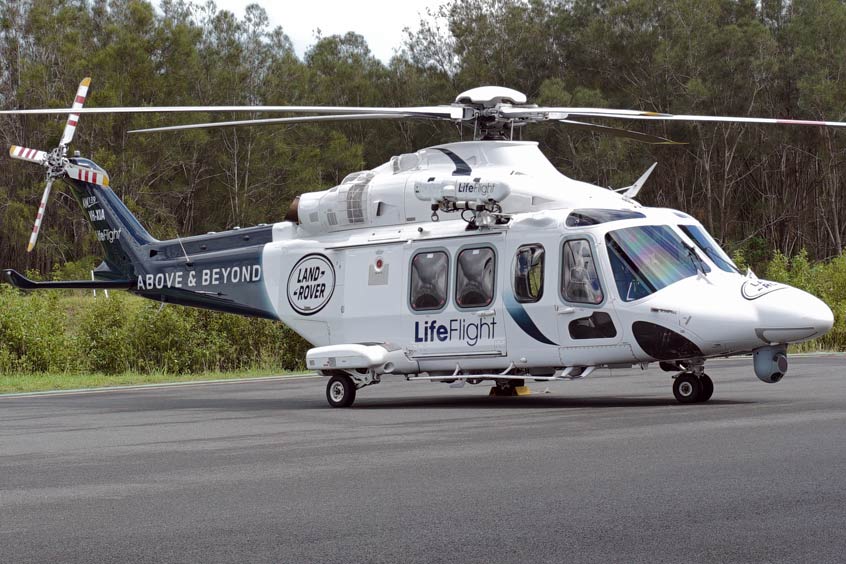Why visit ACE ’25?

A highly advanced, specially configured helicopter, designed to take on the most challenging missions, is operational and ready to respond around the clock to emergencies anywhere in Australia. The Land Rover LifeFlight Special Mission helicopter was unveiled today by LifeFlight, Australia's aeromedical retrieval service, with crew performing a winch operation and demonstrating some of the aircraft's advanced capabilities. The type is an Leonardo AW139.
The Land Rover LifeFlight Special Mission helicopter is a fully integrated aircraft, which can operate in extreme situations from offshore in the wildest ocean conditions, to the most rugged and hostile inland environments. The human-machine interface, aircraft type, specialist mission equipment, technology, experienced aeromedical crews, location and availability all combine to make the helicopter the only aircraft of its type, available for immediate deployment by civil agencies in Australia and beyond.
“The Land Rover LifeFlight Special Mission helicopter is dedicated to emergency response, such as SAR, law enforcement, fire-fighting support, surveillance, aeromedical and disaster response operations,” says LifeFlight commercial director Yvette Lutze.
Every detail of the aircraft is specifically designed for emergency response deployment. It is one of the few aircraft in Australia equipped and crewed to perform missions up to 400 km offshore, including winch rescues, even at night.
“It's one of only a few in the country that can descend at night and maintain a hover at 50 ft. The auto hover can lock the machine in position over a survivor, even if the survivor is moving with a tide, or being lifted up and down in rough seas,” explains Land Rover LifeFlight Special Mission chief pilot Paul Forcier.
Dual hoists are a vital feature that allow the aircraft to go above and beyond most other emergency response choppers. “The dual hoist is critical for performing winch rescues at long distances out to sea, when you need to ensure the remote possibility of equipment failure will not jeopardise the mission. There is always a back-up,” Forcier continues. The Forward Looking Infra-Red (FLIR) is the crew's all-seeing eye-in-the-sky, which is able to pick up heat signatures from over water, or land. “The FLIR can 'lock on' to the heat signature and allow us to follow the person, even if they can’t be seen or they're moving, maybe caught in swift water or running from danger on the ground, or even trying to outrun law enforcement," Paul Forcier said. "It's a huge technological advantage, when rescuing multiple people who are moving, or in low visibility conditions, for example a group of people dispersed in the water from an overturned vessel.”
The dedicated special mission service draws on the skills of LifeFlight’s aviation, engineering and medical crews, and the organisation’s more than 40 year history of aeromedical service, SAR and emergency response operations. The Land Rover LifeFlight Special Mission helicopter is currently on stand-by to undertake missions on behalf of Australian emergency response agencies and is also available for private commercial charter.
“This aircraft not only excels in search and rescue situations. It can be very quickly reconfigured to suit any emergency response requirement. The crew can use the onboard technology to pick up hot spots before bushfires flare out of control, or to find survivors amongst the devastation of natural disasters. It has the capability to help communities in the aftermath of fire, flood and other catastrophic events,” adds Lutze.
Jaguar Land Rover MD Mark Cameron concludes: “Like Land Rover, LifeFlight has an unrivalled commitment to going above and beyond, both in terms of excellence and innovation, and more broadly in the organisation’s decades long and proven dedication to servicing Queensland and beyond. We are proud to partner with a like-minded organisation and offer our support to the Land Rover LifeFlight Special Mission chopper, which will now offer a first of its kind rescue operation servicing Australian communities, across land, air and sea. We remain committed to playing our role in supporting these communities at large, and in partnership with LifeFlight rescue services, we look forward to a long and impactful relationship setting the benchmark for future rescue operations.”
The Land Rover AW139, which can fly up to 270 km/h, travel over 800 km before refuelling and airlift up to 2,200 kg, will be based at LifeFlight's Archerfield West facility in Brisbane.